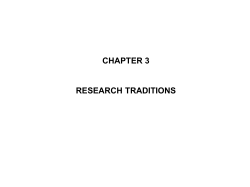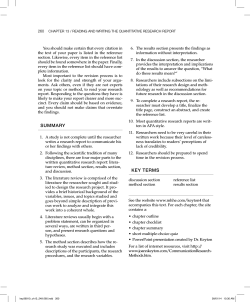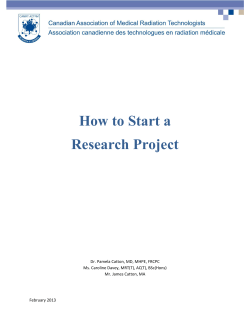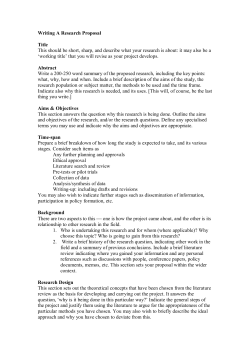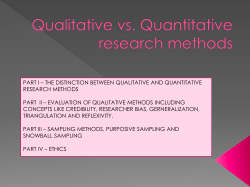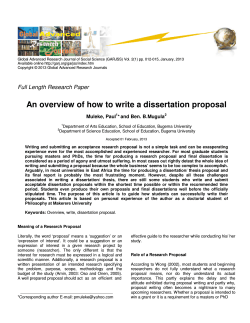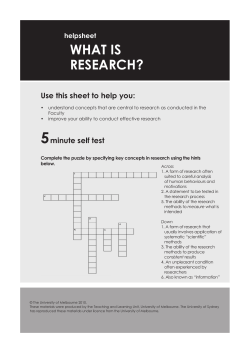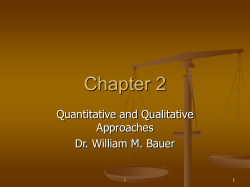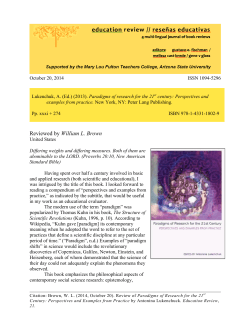
Research Paradigms Qualitative Research Concepts
Research Paradigms Qualitative Research Concepts Most quantitative research texts identify three primary types of research: • Exploratory – research on a concept, people, or situation that the researcher knows little about. • Descriptive – research on a concept, people, or situation that the researcher knows something about, but just wants to describe what he/she has found or observed. • Explanatory – involves testing a hypothesis and deriving that hypothesis from available theories. Generally these types of studies fit within our understanding of qualitative and quantitative research. • Exploratory research involves qualitative studies (observation, interviews, and content analysis) • Explanatory research involves quantitative studies and hypothesis testing. • Descriptive studies most often involve quantitative research techniques or a combination of qualitative and quantitative method. (Please note however, that Rossman & Rollis use the term descriptive to describe some types of qualitative research) When researchers talk about different approaches to research, they talk about “paradigms.” • A paradigm is a “worldview” or a set of assumptions about how things work. • Rossman & Rollis define paradigm as “shared understandings of reality” • Quantitative and qualitative research methods involve very different assumptions about how research should be conducted and the role of the researcher. Differences between qualitative and quantitative research • Involves unstructured interviews, observation, and content analysis. • • • • • Subjective Inductive Little structure Little manipulation of subjects Takes a great deal of time to conduct Little social distance between researcher and subject • • • • • • • • Involves experiments, surveys, testing, and structured content analysis, interviews, and observation. Objective Deductive High degree of structure Some manipulation of subjects May take little time to conduct Much social distance between researcher and subject Lets talk about some of the assumptions or values that are part of qualitative or quantitative paradigms: For example, do you think: That the “truth” can be determined in every situation? Can everyone agree on the truth? What evidence do you need to determine what is the truth? How is knowledge or truth generated? • Are things true if they are printed in books or the newspaper? • Who determines the truth? • Can different people hold different perceptions about what is the “truth”? • Is an individual’s perception of the truth determined by his or her experiences and interactions with other people? Should society change or should it stay the same? • Is it the researcher’s responsibility to change society? • Or should the researcher remain objective or neutral and only attempt to find new knowledge? Should the researcher’s personal experiences and values influence his or her research? • If so, how does the researcher prevent personal bias from influencing the study? To review, qualitative research is: • Subjective – different people can perceive the truth differently. Qualitative research attempts to find out how people perceive their lives. Different people will have different perspectives. The researcher’s experiences, beliefs, and values are incorporated into the research design and analysis of data. In general, research bias is controlled by: • Keeping records on the research process, data analysis, and problems encountered. • Conducting research in a systematic way. • Involving colleagues and research participants in research design and data analysis. • Being “upfront about the researcher’s own beliefs & values. • (We will discuss specific techniques later in the course) Purpose of most qualitative research is to: • Increase knowledge of people or situations that are not usually studied (especially, the experiences of women, persons of color, and people who are often marginalized in society) • Provide information that can be used for social change. Examples of research often used for social change: • Feminist research (assumes women are oppressed in society – research is to be used to help reduce discrimination). • Participatory action research – people affected by a social problem work with a researcher to study a problem, collect data, analyze data, make recommendations, and use the results to influence social change. Rossman & Rollis identify 4 different paradigms – but the two primary paradigms are: • • Positivism – associated with quantitative research. Involves hypothesis testing to obtain “objective” truth. Also used to predict what may happen at a future date. Critical realism is a subtype of positivism that incorporates some value assumptions on the part of the researcher. It involves looking at power in society. Researchers primarily rely on quantitative data to do this. Interpretivism –associated with qualitative research. Used to obtain an understanding of the word from an individual perspective. Critical Humanism is a subtype of the Interpretive paradigm. The critical humanism approach is one in which the researcher involves people studied in the research process. Data is used for social change. Two terms from the book that we should talk about. • Community of practice: People you work and consult with in the course of a study. A community of practice helps you incorporate other points of view in your work. • Reflexivity – the relationship between the research and people being studied. The presence of the researcher affects the people being studies (think of the Hawthorne Effect from SWRK 170!). The researcher is also influenced by the people studied. Reflexivity in qualitative research also pertains to the requirement that the researcher think about what he or she has found as well as the process of doing research. Two other important terms. • Emic – the insider’s view and voice. • Etic. The outsider’s view and voice. ***Researchers are most often outsiders trying to understand a community, group, or individuals. Emic refers to the view of people in the community or the individuals studied. However, there are different approaches to qualitative research that vary in the amount of “social distance” between the researcher and people studied. Next week we will listen to an interviewer who became a part of the community he studied! Exercise for Today: In groups, choose an object with which you and your group members are familiar (for example, a can of Pepsi). Hand the object to one person and ask her to describe it in any way she chooses. Continue this process with four or five people until you run out of things to say. Having heard other’s descriptions, in what way do you see the object differently. How have individual descriptions changed.
© Copyright 2025
